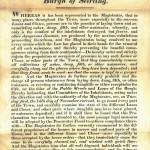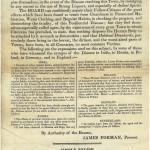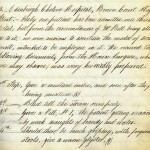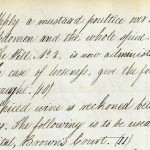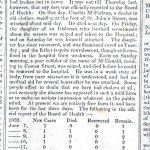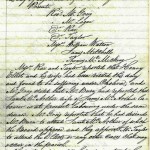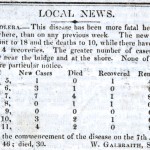The cholera epidemic of 1831-1832 hit the country hard. Arriving in North East Britain as part of a European pandemic, the outbreak would spread though Scottish towns and cities. The disease was was particularly severe in industrialised towns and cities. Overcrowding, no clean water supply and filthy districts ensured that the disease would spread effortlessly. The disease would kill a third of Stirling’s population over thirty years.
The first indication of action from Stirling Burgh to counter the disease came in a proclamation by order of the Magistrates in November 1831. The proclamation notes that many lanes and closes had become cluttered with ‘ash, dung, filth, and other nuisances’ and that ‘fevers and other dangerous diseases are produced by the noxious exhalations’ from them. An order was issued to those of ‘lower orders’ in the lanes and closes to clean their houses and areas with ‘quick lime’.
Proclamations were not enough, however, and the government realised it had to act and asked local authorities and parishes to set up their own Boards of Health. A meeting in Stirling on 27th between Magistrates, Clergymen and Medical Practitioners was the first to consider setting up a Board of Health for the Burgh. The Board was established on the 3rd January 1832 with St Ninians Parish also forming a Board of Health on 13 July 1832. Action by the Stirling Burgh Board of Health began immediately with a monograph produced with instructions for District Committees to combat and monitor the disease.
Our 40th anniversary document concerns a public health poster issued to the inhabitants of Stirling. Produced on the 9th January, it is a rare insight in to the actions of the Burgh to deal with the threat of the cholera epidemic. The poster states that a combination of inotixcation, habitual drunkeness and dirty streets, particularly in the lower classes, were the reasons for the disease spreading quickly. A simple recipe for cleaning and fumigating was also provided.
In January 1832 cholera had reached Haddington in East Lothian and quickly spread to Edinburgh and Glasgow. The Board of Health took the decision to travel to special Cholera Hospitals that had been set up in Edinburgh, Musselburgh and Tranent. Here they learned of the various techniques designed to help patients with the disease.
Returning from Edinburgh, the Board of Health immediately asked for the Stirling Military Hospital to be converted in a Cholera Hospital. The Council refused but stated that the Guild Hall in Stirling would be converted with ’12 bedsteads to be immediately placed in the Lower Guild’.
Stirling recorded its first case of Cholera on 7th June 1832. Reported in the Stirling Journal, the town would see a gradual increase in those infected. In St Ninians the first recorded case occurred in August 1832.
The epidemic in 1831-1832 would not hurt Stirling as bad as Paisley or Glasgow. A report from William Galbraith of the Board of Health on 11th July 1832 would confirm that there had been 46 cases of the disease and 30 deaths. At the end of August, Cholera had been contained and there with an additional six deaths. The surrounding towns of Stirling were largely Cholera free until 1833 when an outbreak hit Dunblane and Bridge of Allan. A report in the November 1833 in the Stirling Advertiser noted there had been 57 cases and 23 deaths.
